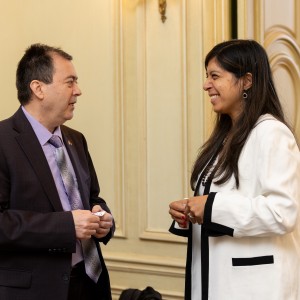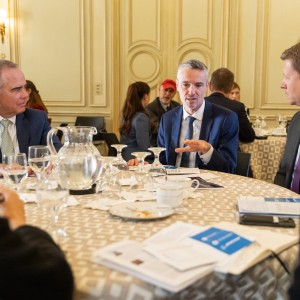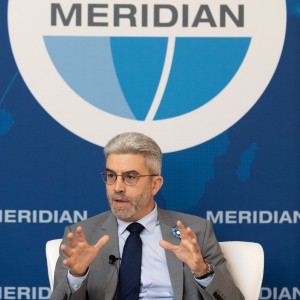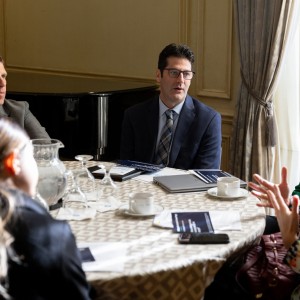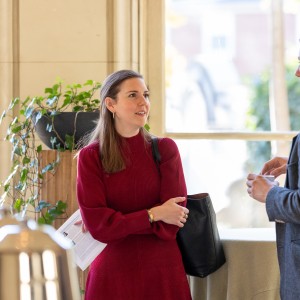Sustainable Aviation Takes Off

November 8, 2023
At the dynamic intersection of aviation and economics, the skies hold not just planes but the promise of prosperity. With strong demand for air travel that is only expected to rise, achieving net-zero climate goals by 2050 is a massive challenge. In partnership with GE Aerospace and Boeing, Meridian welcomed a cross section of stakeholders to Meridian House to deepen their understanding of innovative aviation sustainability efforts and the potential for sustainable aviation fuels (SAF), carbon offsets, and eco-friendly technologies to revolutionize the industry.
The program featured a distinguished lineup of public and private sector speakers who examined crucial aspects of emerging technologies, SAF policy, financing frameworks, and collaborations driving change around the globe. With introductory remarks by Meridian Executive Vice President, Natalie Jones, the speakers included:
- Megersa Abate, Senior Transport Economist, The World Bank
- Erin Donnette, Senior Strategist, North American Sustainability Policy, The Boeing Company
- Chaitan Jain, Director of International Regulatory Affairs, United Airlines
- Maxime Millefert, Counsellor, Head of Ecology, Sustainable Development, Energy and Transport Division, Embassy of France
- Anna Oldani, General Engineer, Federal Aviation Administration APL Office of Environment and Energy, U.S. Department of Transportation, U.S. Department of Transportation
- Allen Paxson, Vice President & General Manager of Commercial Strategy, GE Aerospace
Here are some top takeaways from the program:
1. Green Revolution in Flight
SAF is revolutionizing the aviation industry, presenting a near-term green alternative to traditional jet fuel. Derived from diverse renewable resources like waste oils, agricultural residues, and even algae, SAFs promise reduced carbon emissions, poised to redefine the future of air travel. SAFs are not a homogenous product and encompass a variety of sources, production methods, and supply chains, which result in differing levels of emissions reductions. There is no silver bullet to reach aviation sustainability, and its promise and potential is dependent on diversified investments across the landscape of SAFs alongside emerging technologies in hydrogen, electric, and new-engine model development.
2. Harmonization in the Skies
As industry titans, smaller innovators, governments, and multilateral organizations work together towards a greener aviation industry, harmonized regulation will be critical. Cohesive regulatory frameworks will help all stakeholders successfully maneuver the rapidly evolving landscape. Currently, the ReFuelEU Aviation Agreement doesn’t count crop-derived fuels toward mandated sustainable fuel use, whereas in the United States those products are incentivized. Different stakeholders, each with unique value-adds, add new dimensions to key processes like research, infrastructure, and regulation. International frameworks, such as the Carbon Offsetting and Reduction Scheme for International Aviation (CORSIA), ensure uniformity in regulations, preventing market distortions and effectively facilitating the industry’s green transition. Mechanisms for harmonization ease the pressure on stakeholders and industry alike.
3. Public-Private Partnerships for Greener Skies
Uniting resources and expertise through public-private collaboration is pivotal to accelerating innovation and economic growth. In France, where the government has prioritized green aviation, and established [via the CORAC] an effective public-private partnership, industry giant AirFrance, like other airlines, has been able to benefit from new-generation aircrafts that emits up to 25% less CO2. This collaboration allows for the development of thorough, effective investment and regulation. Further, the involvement of government, particularly when it comes to financing, makes smaller companies less risk-averse, resulting in better, more innovative technological outcomes.
4. Sustainable Strategies: The “Carrot and Stick” Approach
Sustainable aviation is not a one-size-fits-all endeavor, and requires tailored strategies to address unique challenges across different regions and sectors. The "carrot and stick" approach for sustainable aviation involves incentivizing eco-friendly practices ("carrot") and imposing regulations or penalties ("stick") to enforce sustainability in the industry. In the U.S., incentives such as grants, tax credits, and subsidies serving as impetus for companies to move towards more sustainable aviation practices. In the E.U., carbon neutrality mandates serve as a regulatory measure to get companies to comply with sustainable aviation standards.
5. Aviation in Developing Nations
As economies and populations continue to grow, the center of gravity in aviation and decarbonization is shifting East, creating opportunities for mid- to low-income countries to capitalize on this transition. With a green premium on clean technology, financing remains a barrier to entry for developing nations looking to embrace sustainable aviation. Private sector support for local and regional manufacturing capabilities and infrastructure development, paired with public and multilateral incentives and financing solutions will be key to making sustainable aviation viable in these markets.
Project summary
| Sustainable Aviation Takes Off | November 2023 | |
|---|---|
| Impact Areas: | Business and Trade, Energy and the Environment, Science and Technology |
| Program Areas: | Diplomatic Engagement |
| Partners: | Diplomatic Corps, Private Sector, Public Sector |


